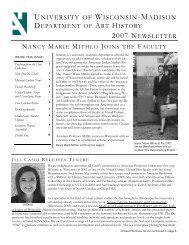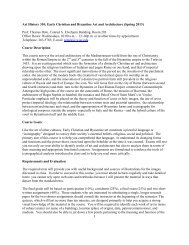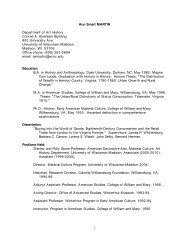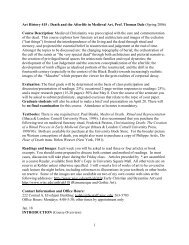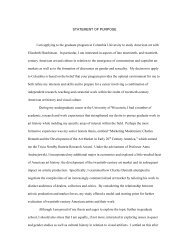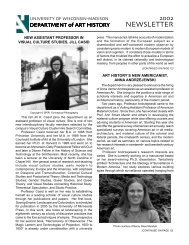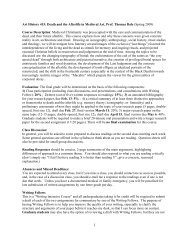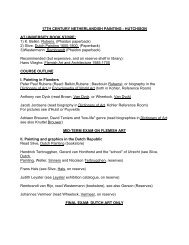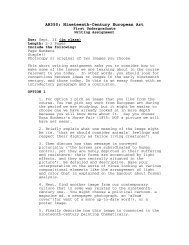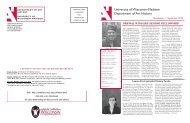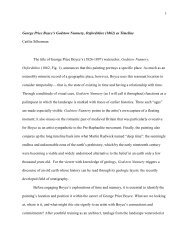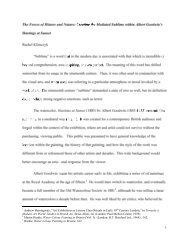Romanesque & Gothic Art & Architecture (Fall 2005) Prof. T. Dale ...
Romanesque & Gothic Art & Architecture (Fall 2005) Prof. T. Dale ...
Romanesque & Gothic Art & Architecture (Fall 2005) Prof. T. Dale ...
Create successful ePaper yourself
Turn your PDF publications into a flip-book with our unique Google optimized e-Paper software.
on-line at http://www.fordham.edu/halsall/source/rul-benedict.html .<br />
What are the essential tenets of the monastic life as outlined in the Benedictine Rule? How<br />
is monastic architecture designed to enhance symbolic and functional distinctions between<br />
individual parts of the monastic complex? What are the differences bewteen Cistercian<br />
from Cluniac monasticism and how are these differences manifested in the art and<br />
architecture of the two orders?<br />
Sept. 12, 17<br />
IV. Revelation, Judgement and Spiritual Passage in the French <strong>Romanesque</strong> Portal<br />
(Moissac and Vézelay; Autun and Conques)<br />
M. F. Hearn, <strong>Romanesque</strong> Sculpture, 102-17; 169-91. Linda Seidel, “The Moissac Portal and<br />
the Rhetoric of Appropriation?” in READER.<br />
What are the essential features of the canonical French Romaneque portals according to<br />
Hearn? What is the significance of the iconography (subject matter) for its location at the<br />
threshold of the church? What role do pictorial structure (composition and narrative<br />
disposition) and inscriptions play in the “reading” of the visual imagery? How does Seidel<br />
depart from conventional characterizations of the portal of Moissac? How does the<br />
framework of the porch condition the viewer’s response to the sculptural program as a<br />
whole? How does it ultimately reinforce the assimilation of the viewer’s entry into the<br />
church building with both the biblical journeys and the viewer’s own reception into the<br />
Heavenly Jerusalem at the end of time?<br />
Sept. 19<br />
V. Monstrosity, Corporeal Deformity and Fantasy in <strong>Romanesque</strong> <strong>Art</strong><br />
Bernard of Clairvaux, Apologia to William of St. Thierry in Davis-Weyer, Early Medieval <strong>Art</strong>,<br />
168-170; Schapiro, "On the Aesthetic Attitude in <strong>Romanesque</strong> <strong>Art</strong>," (1947) in <strong>Romanesque</strong><br />
<strong>Art</strong> (New York, 1977/1993), 1-27 and READER; T. <strong>Dale</strong>, “Monsters, Corporeal Deformities,<br />
and Phantasms in the Cloister of St-Michel-de-Cuxa,” <strong>Art</strong> Bulletin 83, no. 3 (2001):402-436<br />
(available both in photocopy on Reserve and in full-text version at<br />
http://wilsontxt.hwwilson.com/pdffull/04407/1Z7G6/3SX.pdf )<br />
What are the origins of the term “fantasy” (phantasy) and how does its medieval meaning<br />
differ from most current definitions? What is the etymology of the term “monster” and how<br />
was it understood by medieval writers? What is Bernard of Clairvaux’s attitude towards art<br />
in general and the representation of monsters and other human and animal subjects in<br />
cloister capitals, in particular? How does Schapiro reinterpret Bernard’s complaint in terms<br />
of artistic creation? How does my own interpretation differ from Schapiro’s? What issues<br />
concerning these images are still left unresolved?<br />
Sept. 24<br />
VI. Eve, Salome and Mary: Defining the Role of Women in <strong>Romanesque</strong> <strong>Art</strong><br />
Petzold, 123-129; Linda Seidel, “Salome and the Canons,” Women’s Studies 11 (1984):29-<br />
66 in READER.<br />
What are the prescribed positive and negative roles for women in medieval Christian<br />
theology and how are they manifested in <strong>Romanesque</strong> art? What is the significance of<br />
3



